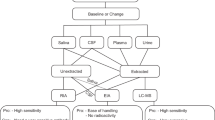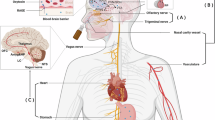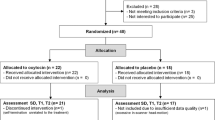Abstract
The neuropeptide oxytocin (OXT) exerts anxiolytic and prosocial effects in the central nervous system of rodents. A number of recent studies have attempted to translate these findings by investigating the relationships between peripheral (e.g., blood, urinary and salivary) OXT concentrations and behavioral functioning in humans. Although peripheral samples are easy to obtain in humans, whether peripheral OXT measures are functionally related to central OXT activity remains unclear. To investigate a possible relationship, we quantified OXT concentrations in concomitantly collected cerebrospinal fluid (CSF) and blood samples from child and adult patients undergoing clinically indicated lumbar punctures or other CSF-related procedures. Anxiety scores were obtained in a subset of child participants whose parents completed psychometric assessments. Findings from this study indicate that plasma OXT concentrations significantly and positively predict CSF OXT concentrations (r=0.56, P=0.0064, N=27). Moreover, both plasma (r=−0.92, P=0.0262, N=10) and CSF (r=−0.91, P=0.0335, N=10) OXT concentrations significantly and negatively predicted trait anxiety scores, consistent with the preclinical literature. Importantly, plasma OXT concentrations significantly and positively (r=0.96, P=0.0115, N=10) predicted CSF OXT concentrations in the subset of child participants who provided behavioral data. This study provides the first empirical support for the use of blood measures of OXT as a surrogate for central OXT activity, validated in the context of behavioral functioning. These preliminary findings also suggest that impaired OXT signaling may be a biomarker of anxiety in humans, and a potential target for therapeutic development in individuals with anxiety disorders.
This is a preview of subscription content, access via your institution
Access options
Subscribe to this journal
Receive 12 print issues and online access
$259.00 per year
only $21.58 per issue
Buy this article
- Purchase on SpringerLink
- Instant access to full article PDF
Prices may be subject to local taxes which are calculated during checkout


Similar content being viewed by others
References
Modi ME, Young LJ . The oxytocin system in drug discovery for autism: animal models and novel therapeutic strategies. Horm Behav 2012; 61: 340–350.
Carson DS, Guastella AJ, Taylor ER, McGregor IS . A brief history of oxytocin and its role in modulating psychostimulant effects. J Psychopharm 2013; 27: 231–247.
Windle RJ, Shanks N, Lightman SL, Ingram CD . Central oxytocin administration reduces stress-induced corticosterone release and anxiety behavior in rats. Endocrinology 1997; 138: 2829–2834.
Amico JA, Mantella RC, Vollmer RR, Li X . Anxiety and stress responses in female oxytocin deficient mice. J Neuroendocrinol 2004; 16: 319–324.
Slattery DA, Neumann ID . Chronic icv oxytocin attenuates the pathological high anxiety state of selectively bred Wistar rats. Neuropharmacology 2010; 58: 56–61.
Petrovic P, Kalisch R, Singer T, Dolan RJ . Oxytocin attenuates affective evaluations of conditioned faces and amygdala activity. J Neurosci 2008; 28: 6607–6615.
Ditzen B, Schaer M, Gabriel B, Bodenmann G, Ehlert U, Heinrichs M . Intranasal oxytocin increases positive communication and reduces cortisol levels during couple conflict. Biol Psychiatry 2009; 65: 728–731.
Hall SS, Lightbody AA, McCarthy BE, Parker KJ, Reiss AL . Effects of intranasal oxytocin on social anxiety in males with fragile X syndrome. Psychoneuroendocrinology 2012; 37: 509–518.
Yuen KW, Garner JP, Carson DS, Keller J, Lembke A, Hyde SA et al. Plasma oxytocin concentrations are lower in depressed vs. healthy control women and are independent of cortisol. J Psychiatric Res 2014; 51: 30–36.
Carson DS, Bosanquet DP, Carter CS, Pournajafi-Nazarloo H, Blasczsynski A, McGregor IS . Preliminary evidence for lowered basal cortisol in a naturalistic sample of methamphetamine polydrug users. Exp Clin Psychopharmacol 2012; 20: 497–503.
Feldman R, Gordon I, Zagoory-Sharon O . Maternal and paternal plasma, salivary, and urinary oxytocin and parent-infant synchrony: considering stress and affiliation components of human bonding. Dev Sci 2011; 14: 752–761.
Parker KJ, Garner JP, Libove RA, Hyde SA, Hornbeak KB, Carson DS et al. Plasma oxytocin concentrations and OXTR gene variants predict social impairments in children with and without autism spectrum disorder. PNAS 2014; 111: 12258–12263.
Fries ABW, Ziegler TE, Kurian JR, Jacoris S, Pollak SD . Early experience in humans is associated with changes in neuropeptides critical for regulating social behavior. PNAS 2005; 102: 17237–17240.
Carter CS, Pournajafi-Nazarloo H, Kramer KM, Ziegler TE, White-Traut R, Bello D et al. Oxytocin: behavioral associations and potential as a salivary biomarker. Ann N Y Acad Sci 2007; 1098: 312–322.
Rubin LH, Carter CS, Bishop JR, Pournajafi-Nazarloo H, Drogos LL, Hill SK et al. Reduced levels of vasopressin and reduced behavioral modulation of oxytocin in psychotic disorders. Schizophr Bull 2014 (in press).
Anderberg UM, Uvnas-Moberg K . Plasma oxytocin levels in female fibromyalgia syndrome patients. Z Rheumatol 2000; 59: 373–379.
Scantamburlo G, Hansenne M, Fuchs S, Pitchot W, Marechal P, Pequeux C et al. Plasma oxytocin levels and anxiety in patients with major depression. Psychoneuroendocrinology 2007; 32: 407–410.
Moons WG, Way BM, Taylor SE . Oxytocin and vasopressin receptor polymorphisms interact with circulating neuropeptides to predict human emotional reactions to stress. Emotion 2014; 14: 562–572.
Zelkowitz P, Gold I, Feeley N, Hayton B, Carter CS, Tulandi T et al. Psychosocial stress moderates the relationships between oxytocin, perinatal depression, and maternal behavior. Horm Behav 2014; 66: 351–360.
Landgraf R, Neumann ID . Vasopressin and oxytocin release within the brain: a dynamic concept of multiple and variable modes of neuropeptide communication. Front Neuroendocrinol 2004; 25: 150–176.
Amico JA, Challinor SM, Cameron JL . Pattern of oxytocin concentrations in the plasma and cerebrospinal-fluid of lactating rhesus-monkeys (Macaca-mulatta)—evidence for functionally independent oxytocinergic pathways in primates. J Clin Endocrinol Metab 1990; 71: 1531–1535.
Kagerbauer SM, Martin J, Schuster T, Blobner M, Kochs EF, Landgraf R . Plasma oxytocin and vasopressin do not predict neuropeptide concentrations in human cerebrospinal fluid. J Neuroendocrinol 2013; 25: 668–673.
Wotjak CT, Ganster J, Kohl G, Holsboer F, Landgraf R, Engelmann M . Dissociated central and peripheral release of vasopressin, but not oxytocin, in response to repeated swim stress: new insights into the secretory capacities of peptidergic neurons. Neuroscience 1998; 85: 1209–1222.
Ross HE, Young LJ . Oxytocin and the neural mechanisms regulating social cognition and affiliative behavior. Front Neuroendocrinol 2009; 30: 534–547.
Spence SH, Barrett PM, Turner CM . Psychometric properties of the Spence Children's Anxiety Scale with young adolescents. J Anxiety Disord 2003; 17: 605–625.
Whiteside SP, Brown AM . Exploring the utility of the Spence Children's Anxiety Scales parent- and child-report forms in a North American sample. J Anxiety Disord 2008; 22: 1140–1446.
Born J, Lange T, Kern W, McGregor GP, Bickel U, Fehm HL . Sniffing neuropeptides: a transnasal approach to the human brain. Nat Neurosci 2002; 5: 514–516.
Szeto A, McCabe PM, Nation DA, Tabak BA, Rossetti MA, McCullough ME et al. Evaluation of enzyme immunoassay and radioimmunoassay methods for the measurement of plasma oxytocin. Psychosom Med 2011; 73: 393–400.
McCullough ME, Churchland PS, Mendez AJ . Problems with measuring peripheral oxytocin: Can the data on oxytocin and human behavior be trusted?. Neurosci Biobehav Rev 2013; 37: 1485–1492.
Yuen KW, Garner JP, Carson DS, Keller J, Lembke A, Hyde SA et al. Plasma oxytocin concentrations are lower in depressed vs. healthy control women and are independent of cortisol. J Psychiatr Res 2014; 51: 30–36.
Carson DS, Howerton CL, Garner JP, Hyde SA, Clark CL, Hardan AY et al. Plasma vasopressin concentrations positively predict cerebrospinal fluid vasopressin concentrations in human neonates. Peptides 2014; 61C: 12–16.
Grewen KM, Davenport RE . Light KC. An investigation of plasma and salivary oxytocin responses in breast- and formula-feeding mothers of infants. Psychophysiology 2010; 47: 625–632.
Harris PA, Taylor R, Thielke R, Payne J, Gonzalez N, Conde JG . Research electronic data capture (REDCap)-a metadata-driven methodology and workflow process for providing translational research informatics support. J Biomed Inform 2009; 42: 377–381.
Miller KA, Garner JP, Mench JA . Is fearfulness a trait that can be measured with behavioural tests? A validation of four fear tests for Japanese quail. Anim Behav 2006; 71: 1323–1334.
Heim C, Young LJ, Newport DJ, Mletzko T, Miller AH, Nemeroff CB . Lower CSF oxytocin concentrations in women with a history of childhood abuse. Mol Psychiatry 2009; 14: 954–958.
Doehrmann O, Ghosh SS, Polli FE, Reynolds GO, Horn F, Keshavan A et al. Predicting treatment response in social anxiety disorder from functional magnetic resonance imaging. JAMA Psychiatry 2013; 70: 87–97.
Guastella AJ, Howard AL, Dadds MR, Mitchell P, Carson DS . A randomized controlled trial of intranasal oxytocin as an adjunct to exposure therapy for social anxiety disorder. Psychoneuroendocrinology 2009; 34: 917–923.
Alvares GA, Chen NTM, Balleine BW, Hickie IB, Guastella AJ . Oxytocin selectively moderates negative cognitive appraisals in high trait anxious males. Psychoneuroendocrinology 2012; 37: 2022–2031.
Labuschagne I, Phan KL, Wood A, Angstadt M, Chua P, Heinrichs M et al. Oxytocin attenuates amygdala reactivity to fear in generalized social anxiety disorder. Neuropsychopharmacology 2010; 35: 2403–2413.
Labuschagne I, Phan KL, Wood A, Angstadt M, Chua P, Heinrichs M et al. Medial frontal hyperactivity to sad faces in generalized social anxiety disorder and modulation by oxytocin. Int J Neuropsychopharmacol 2011; 14: 1–14.
Neumann ID, Wigger A, Torner L, Holsboer F, Landgraf R . Brain oxytocin inhibits basal and stress-induced activity of the hypothalamo-pituitary-adrenal axis in male and female rats: partial action within the paraventricular nucleus. J Neuroendocrinol 2000; 12: 235–243.
Knobloch HS, Charlet A, Hoffmann LC, Eliava M, Khrulev S, Cetin AH et al. Evoked axonal oxytocin release in the central amygdala attenuates fear response. Neuron 2012; 73: 553–566.
Bale TL, Davis AM, Auger AP, Dorsa DM, McCarthy MM . CNS region-specific oxytocin receptor expression: importance in regulation of anxiety and sex behavior. J Neurosci 2001; 21: 2546–2552.
Kalin NH, Gibbs DM, Barksdale CM, Shelton SE, Carnes M . Behavioral stress decreases plasma oxytocin concentration in primates. Life Sci 1985; 36: 1275–1280.
Parker KJ, Buckmaster CL, Schatzberg AF, Lyons DM . Intranasal oxytocin administration attenuates the ACTH stress response in monkeys. Psychoneuroendocrinology 2005; 30: 924–929.
Meinlschmidt G, Heim C . Sensitivity to intranasal oxytocin in adult men with early parental separation. Biol Psychiatry 2007; 61: 1109–1111.
Weisman O, Zagoory-Sharon O, Feldman R . Oxytocin administration alters HPA reactivity in the context of parent-infant interaction. Eur Neuropsychopharmacol 2013; 23: 1724–1731.
Cardoso C, Ellenbogen MA, Orlando MA, Bacon SL, Joober R . Intranasal oxytocin attenuates the cortisol response to physical stress: a dose-response study. Psychoneuroendocrinology 2013; 38: 399–407.
Seckl J, Lightman S . Cerebrospinal fluid neurohypophysial peptides in benign intracranial hypertension. J Neurol Neurosurg Psychiatry 1988; 51: 1538–1541.
Saunders NR, Liddelow SA, Dziegielewska KM . Barrier mechanisms in the developing brain. Front Pharmacol 2012; 3: 46.
Amico JA, Levin SC, Cameron JL . Circadian-rythm of oxytocin in the cerebrospinal-fluid of rhesus and cynomolgus monkeys—effects of castration and adrenalectomy and presence of a caudal-rostral gradient. Neuroendocrinology 1989; 50: 624–632.
Wang YL, Yuan Y, Yang J, Wang CH, Pan YJ, Lu L et al. The interaction between the oxytocin and pain modulation in headache patients. Neuropeptides 2013; 47: 93–97.
Altemus M, Fong J, Yang RR, Damast S, Luine V, Ferguson D . Changes in cerebrospinal fluid neurochemistry during pregnancy. Biol Psychiatry 2004; 56: 386–392.
Jokinen J, Chatzittofis A, Hellstrom C, Nordstrom P, Uvnas-Moberg K, Asberg M . Low CSF oxytocin reflects high intent in suicide attempters. Psychoneuroendocrinology 2012; 37: 482–490.
Martin J, Kagerbauer SM, Schuster T, Blobner M, Kochs EF, Landgraf R . Vasopressin and oxytocin in CSF and plasma of patients with aneurysmal subarachnoid haemorrhage. Neuropeptides 2014; 48: 91–96.
Acknowledgements
We are grateful to the members of the Parker and Hardan laboratories, the nurses and doctors at Stanford Hospital & Clinics and Lucile Packard Children's Hospital, and, of course, the patients and their families for participating in this study. This research was supported by an Autism Speaks Meixner Postdoctoral Fellowship in Translational Research (7895; DSC), a Stanford University School of Medicine Dean’s Postdoctoral Fellowship (DSC), the Katherine D. McCormick Fund (KJP), the Mosbacher Family Fund for Autism Research (KJP), Stanford’s Bio-X NeuroVentures Program (KJP), the Weston Havens Foundation (KJP) and by an NIH/NCRR grant to the Stanford Center for Clinical Informatics (UL1 RR025744).
Author information
Authors and Affiliations
Corresponding authors
Ethics declarations
Competing interests
The authors declare no conflict of interest.
PowerPoint slides
Rights and permissions
About this article
Cite this article
Carson, D., Berquist, S., Trujillo, T. et al. Cerebrospinal fluid and plasma oxytocin concentrations are positively correlated and negatively predict anxiety in children. Mol Psychiatry 20, 1085–1090 (2015). https://doi.org/10.1038/mp.2014.132
Received:
Revised:
Accepted:
Published:
Issue Date:
DOI: https://doi.org/10.1038/mp.2014.132



